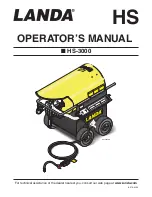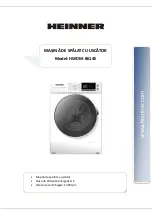
Safety Regulations
2 — 6
APS03_013_0404GB
It is essential that correct high−pressure hoses be carefully selected
and handled correctly to maintain the operational safety of the
high−pr essure cleaner.
Observe the following rules when handling high−pressure hoses:
− High−pr essure hoses that are marked with a permissible operating
overpressure lower than the one specified in the technical
specifications or hoses that have no markings at all, should not be
used.
− High−pr essure hoses must be laid and secured in order to prevent
any danger should the hose lines burst.
− High−pr essure lines must consist of functioning hoses and
connections that are compatible with each other.
− High−pr essure hoses must not be painted.
− High−pr essure hoses should only be connected by specially
trained and qualified persons.
− Depressurise high−pressure hoses after operation.
− Do not crush high−pressure hoses or lay them over sharp edges.
Avoid tensile and bending loads.
− High−pr essure hoses must be stored free of kinks and tension.
High−pr essure hoses are wearing parts with a limited service life.
They should therefore be replaced at appropriate intervals according
to the operating conditions, even if there are no obvious external
defects.
The hoses must be replaced when the following defects occur:
− Scuff marks, cuts or cracks that pierce the outer layer and reach
through to the wire infill.
− Embrittlement of the outer layer (crack formation) due to improper
storage.
− Storage limit and usable service life have expired. As a reference
value, DIN specifies 6 years plus a maximum of 4 years previous
storage time for an unconnected hose.
− Leaks in the hose and at the connection point.
Never search for leaks in high−pressure hoses or pipes with your
bare hands. An escaping high−pressure jet may not be visible and
can cause serious injury.
2.5
Handling high-pres-
sure hoses
















































